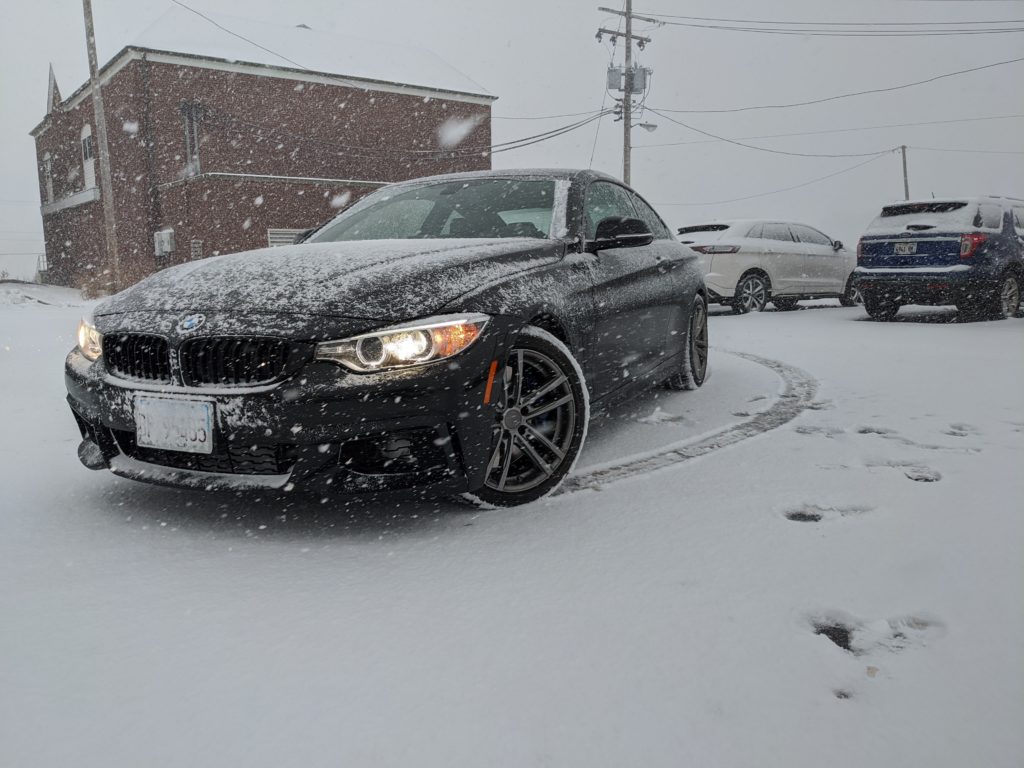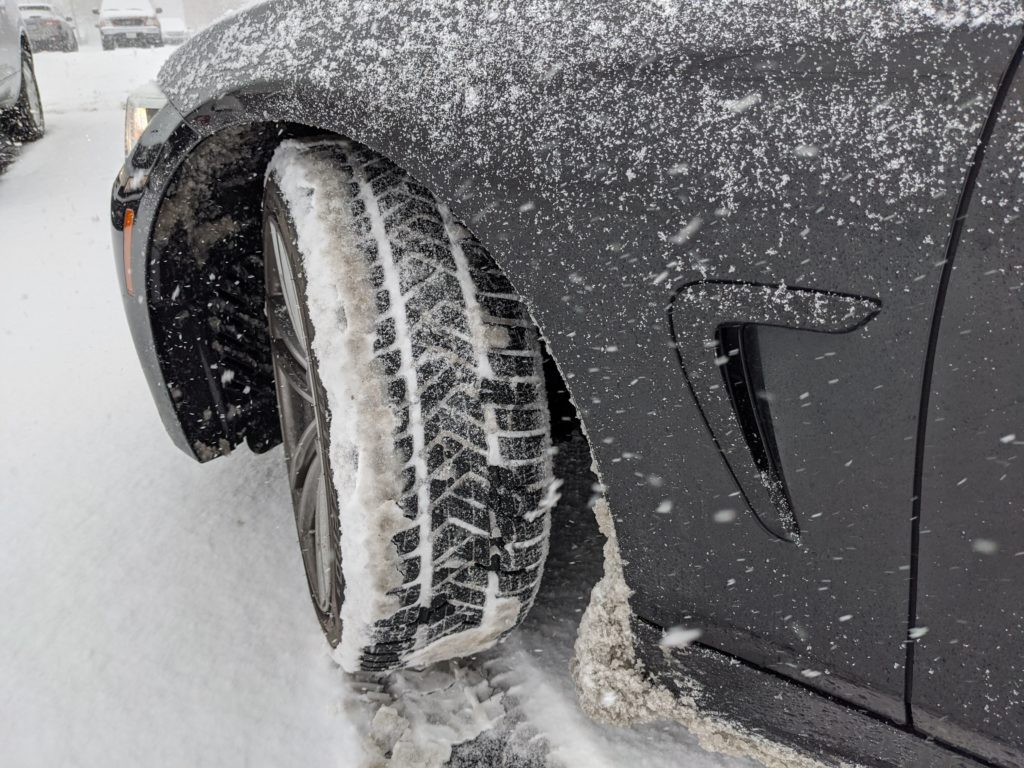
Winter finally hit my area full force, which makes writing about detailing, racing, or even the joys of driving nearly impossible, but it does provide a a great opportunity to discuss winter tires and why you should get them. This time of year news stories on the topic are everywhere, and for good reason.
Several months ago I wrote about the joys of mounting my summer tires and how much they improved the driving experience. This time around I’ll discuss going from summer to winter tires and why it’s a good idea. The most obvious advantage is you can continue to drive your performance car year-round without resorting to driving a “winter beater” or suffering through winter in an AWD SUV or 4×4 truck.
Realizing the need
I’ll be the first to admit I’ve made some really poor tire choices in the past. Some, like running summer tires year round in my first BMW many years ago, were made out of ignorance. Others were made out of necessity, or believing I could get away with “good enough”. However, as I’ve gained first-hand experience and researched the topic, I really see the need for tires specializing in winter conditions.
The greatest awareness of the difference between tire types came when I mounted summer tires on my GTI. Michelin Pilot Super Sports have all sorts of warnings making it sound like any owner will fly off the road and die in a fiery crash if the tires see temperatures below 42 degrees Fahrenheit. If you managed to not die while driving in very cool temps, the tires would surely crack and leave you with unusable tires. I survived driving on those tires in cooler than recommended temperatures, but I did experience first-hand how the rubber compound hardens and grip becomes limited below certain temperatures. When I paid close attention to how the car behaved, I felt the limited grip in the dry and really noticed how it degraded in the wet. I happily swapped my summer set-up for one with Continental all season tires as soon as temperatures stayed steadily in the 40’s.
Over the years I read articles about all season tires not being a good substitute for winter tires and watched videos from reputable sources like Tire Rack demonstrating the differences between the two types of tires. Despite all of the evidence, I felt it didn’t apply to me since I live in an area with fairly mild winter weather. Two weather events over the last couple years changed my mind. The first was an ice store which rolled across my area while I was at work one day. I left work to discover a nearly friction less road surface which snarled traffic for hours. I made it home safely simply by using every slick condition driving technique I know and the little bit of grip provided by the all season Continental DWS06 tires on the car at the time. It was nerve racking to say the least and I was fortunate to make it home safely. The second event was a not-that-uncommon snow storm which deposited only a few inches of snow in my area. Despite the snow not being too deep, the all season tires were not getting much grip and driving the car safely was very difficult. At that point, I knew there had to be something better.
Choosing a tire

I recently purchased a new car in Juyly equipped with a brand new set of summer tires. A glance at the calendar showed I’d only have a few months on those tires before needing something better suited to winter. Initially I thought about going with another set of all season tires, but then remembered back to those really challenging times times driving in winter weather and knew they wouldn’t cut it.
The biggest problem with living in my area is we are just below the “snow belt”. Anyone living only 90 miles north will experiences much more snow, but we still can see a few light snow storms, long periods of significant cold weather, and even plenty of ice, sleet, and rain. Despite all that, in recent years it isn’t uncommon to see long periods of cold dry weather with a few wild temperature swings which get unseasonably warm. These conditions are a little to light for “serious” winter tires and too harsh for all season tires. To make matters worse, my car has the optional performance brakes which limit wheel and tire sizes.
After lots of reading and researching, I narrowed my search to to a category Tire Rack likes to call “performance winter/snow”. These tires have higher speed ratings than most winter tires and better suited for a mixture of winter driving conditions. They won’t have the ultimate grip levels in deep snow found in more dedicated tires, but they will hold up much better on dry roads. These tires are made from a rubber compound designed to stay soft in very cold conditions and have tread patterns designed for slushy, snowy roads. All these features, make them ideal for the weather I face and will ensure safer driving than any all season tire. Surprisingly, the prices are very similar to all season tires in the same size. This made the choice to go with this class of tire even easier. Based on price and size availability I settled on Pirelli’s Winter Sottozero 3.
Recent experience
I ordered the tires along with a set of wheels in early October as temperatures fell, but a spike of warmer weather in early November made me doubt my rush to be ready for winter. Weeks later, a rapid change in weather and an early snow justified my decision. Since then I’ve had plenty of opportunities to validate my decision.
Through November the weather steadily worsened. Within days of the wheels going on the car I experienced an early fall snow storm which simply made the roads a little slushy. Weeks later, a bigger storm hit with more snow, slush, and lots of ice. This was followed by days of very cold temperatures and heavy rain and topped last week with one of the biggest snow storms I’ve experienced in the 10 years I’ve lived in this area.
Through it all, the tires performed perfectly and I realize now how much better they are than all season tires I’ve used in the past. When temperatures drop, all season tires will get louder as the tread hardens and you can feel grip start to lessen, even if just a bit. With these winter tires, they get better! Handling and grip improves in the cold (they can be a bit squishy in temps above 50 degrees F) while road noise decreases. In every weather condition experienced so far I’ve had no problems driving a high-horsepower, rear wheel drive, manual transmission coupe. Most people would say it would be a death-trap in the winter, but appropriate tires are the great equalizer. Even on unplowed roads covered in over five inches of fresh snow I was able to safely start moving, break, and turn. This is in stark contrast to my neighbor with a car very similar to mine running a set of new all season tires required help driving up her driveway with only an inch or so of fresh snow and slush on her freshly shoveled driveway. There is always a need to drive appropriately for the conditions, but the level of control in all of those conditions is far beyond anything I experienced with all season tires.
Final comments and advice
Five years ago, I firmly believed a quality all season tire like the Continentals were all you needed in this area. Today, I feel much differently. If you live in warmer climates which rarely sees temperatures below freezing and you only encounter rain, it’s a great tire along with other performance all season tires. It won’t grip like a summer tire, but if you don’t want to swap tires each winter, they are a great year round choice.
Should you live in a an area which gets colder and snowier, I highly encourage winter tires. Even if you are fortunate to live in an area where the roads are well maintained and plowed, having the extra grip in all conditions (rain, snow, or dry) will only make you safer on the road. To make life easier, buy a second set of wheels for the winter tires. This saves you from visiting a tire shop each winter to mount and balance your winter tires and allows you to mount them on your car yourself whenever needed. Many tire shops will do a wheel/tire special, or you can find used wheels from various sources. Dealerships may have packages as well, but they are far more expensive in most cases.
In the end, choose something appropriate for your weather conditions, drive safely, and dream of spring when you can really hit the road and enjoy driving in warm weather again.

Like!! Thank you for publishing this awesome article.